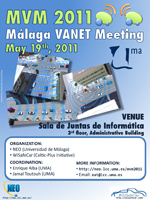DIRICOM
Intelligent Design of a Wireless Transmission Network - Radio Network Design (RND)
When setting up a radio network infrastructure, the main task is to place the base station antennae. This is specially important for cellular networks like GSM, since the location of the antenna determines its coverage cell and, ultimately the total coverage of the network. Besides, the installation of a telephony antenna is not trivial, since a suitable location has to be found that provides a high coverage and is far from restricted areas as schools or hospitals. Furthermore, these installations have a high associated cost, derived from the equipment employed and the rent of the site, generally a building block. Therefore, the antenna location problem, also known as Radio Network Design (RND) is a critical task that can attain a high complexity when it has to be realized for a wide area such as a big city
This task can be defined as an optimization problem in which the goal is to obtain the highest coverage possible while using the lowest number of antennae possible, and placing those only in a set of available location sites (which will likely be rooftops). This way combinatorial optimization techniques can be successfully employed to obtain efficient antannae configurations in a reasonable time delay. A fitness function that determines a merit value for each solution according to the problem objectives is defined:
Fitness = (Coverage percentage)^2 / (#Antennae)
We are currently working on a real-world sized RND instance that is intended to give radio coverage to the city of Malaga (see next figure). This instance contains up to 1000 available location sites distributed over the city rooftops.





 (EMARTV)
(EMARTV)
